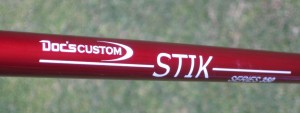Golf Shafts (Getting The Right Flex)
 Golf Shafts are an very important part of the golf club. They do much more than just connect you to the club head, they bend and recoil in very important ways that can increase consistency and add distance, or if you have the wrong shaft for your swing speed rob consistency and distance.
Golf Shafts are an very important part of the golf club. They do much more than just connect you to the club head, they bend and recoil in very important ways that can increase consistency and add distance, or if you have the wrong shaft for your swing speed rob consistency and distance.
Different Flexes of Golf Shafts
Golf shafts come in a number of levels of flexibility (called flex). Below is a list of shaft flexes and a short description of the type of player who would benefit from using each one:
- Extra-Stiff (XS): These shafts are used by golf pros and low handicappers with very fast swing speeds (club head speeds of 100 mph or more).
- Stiff (S): Stiff golf shafts are used by low handicappers who have a fast swing speed but not fast enough to get an extra-stiff shaft to kick (club head speed of ~95-100 mph)
- Regular (R): These shafts should be used by most amateur golfers. They will kick with an average swing speed or around 80-90 mph.
- Senior: Senior flex golf shafts are a bit more flexible than regular shafts. If you are starting to lose your flexibility and swing speed due to age or injury these shafts will help you get back those lost yards off the tee.
- Ladies: These shafts are designed for the average female golfer. If you are a female golfer with a faster swing speed you might experiment with a regular flex shaft
- Junior Flex: Junior shafts are great for kids because they allow kids to still get the shaft to kick and get that added distance that will make the game more fun.
Importance of Having the Right Golf Shaft Flex
The golf shaft is said to be the engine of the golf club, so you’ll want to make sure you’re playing an appropriate flex shaft for your swing speed. The right shaft will help you get the most out of your clubs.
The shaft is the swing engine because it stores much of the power your create in your downswing. When you accelerate the club downward in the downswing the shaft should flex. This flex stores energy because the shaft is elastic.
Because the shaft is elastic it really wants to straighten back out. The continued acceleration in the downswing keeps it flexed until impact with the ball. At impact properly loaded golf shafts straighten back out (kicks), propelling the ball even further than it would have otherwise gone.
If your golf shafts are too stiff for your swing speed you won’t be able to get them to bend in the downswing and won’t be able to take advantage of the added yards from the kick.
If your golf club shafts are too soft for your swing speed you will get too much flex in your downswing. Too much flex can result in less control and unreliable shots. When the shaft bends too much the club head can actually get offline (meaning your hands are in the right place but the club head isn’t).
When a shaft is properly fitted to your swing you will definitely see the difference in how you play the game.
To learn how to properly load your shaft in the downswing watch this short golf shaft loading video lesson from golf Pro Bill McKinney